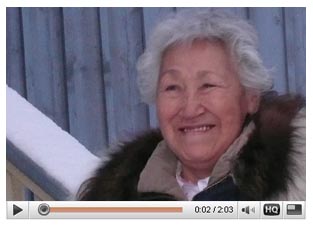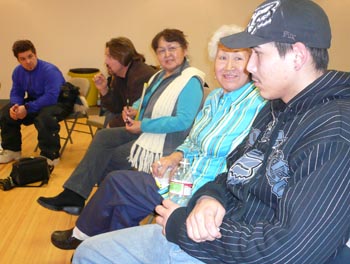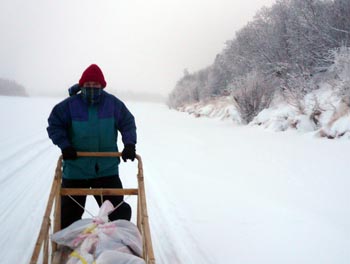Elder Annie Lou Williams lives in a small Native village in the Kuskokwim region of Alaska known as Upper Kalskag. Her ways are simple and traditional.
"The river is alive and it helps me to survive. I drink the water, and everything that is connected to the land is connected to the water," said Williams.
|
The Kuskokwim River originates in Denali National Park, on the north side of Mt. McKinley, and flows 825 miles into the Bering Sea. It is the longest free-flowing river in the United States. The drainage area is roughly the size of the state of Washington.
This vast and remote area is home to 29 Native villages. "Most of the villages have fish camps along the river. We use the river to gather the wood for smoking our food," said Williams. "It's just our way of life."
Helping protect this way of life is an important part of the Indian Law Resource Center's work. The region faces a proposed cyanide heap-leach gold mine on Donlin Creek. The mine would mean increased barge traffic on the River, and a greater risk of fuel spills and contamination from mining tailings, all of which threaten the health of the watershed and the Native subsistence way of life.
"It would change everything," says Williams.
The Center is helping the Kuskokwim River Watershed Council as it works to promote consensus based environmental stewardship. The primary goal is to help the people who depend on the River work together to protect the environmental integrity of the watershed and maintain their traditional subsistence lifestyle.
|
The Native people of the Kuskokwim River watershed truly value their traditional lands and waters. Their cultures, ceremonies, and traditions are inextricably tied to their historic territories. Yet the value of the land goes beyond cultural survival - it actually forms the basis of their physical survival. Native Alaskans from the Kuskokwim region estimate that over 90% of their diet comes from their subsistence lifestyle - from what they hunt, fish and gather - and over 50% of that comes from the salmon. With degradation of the lands and waters will come inevitable impacts on the continued subsistence lifestyle of the Kuskokwim peoples.
There is wide recognition among the people of the Kuskokwim of the potential environmental threats caused by mining. But these communities are also faced with a need for employment, economic security, and basic infrastructure developments. Most households do not even have indoor plumbing, and they rely on diesel fuel generators for electricity. Conflict over the Donlin Creek mine has made it very hard for the people of the River to come together to address their common concerns.
|
In an effort to develop a common vision that all people within the region can support, the Center and the Kuskokwim River Watershed Council organized three meetings this past December in different parts of the watershed - in Bethel, a lower river community with a high reliance on commercial fishing; in Crooked Creek, the location of the proposed Donlin Creek mine; and in Sleetmute, a small village in the upper river region. Each meeting involved a roundtable discussion among community members about their concerns, hopes and fears regarding the proposed Donlin Creek gold mine, and their relationship with the River and surrounding lands, all with a view towards identifying common ground.
Center staff talked with individuals on both sides of the mining issue. Despite conflicting views, everyone agreed that if the mine starts up, there needs to be effective environmental monitoring, strong mitigation measures, and a thorough reclamation plan that has adequate bonding by the mine owners.
The Center's future work with the Kuskokwim River Watershed Council will focus on expanding the technical and political capacity of the tribal governments of the Kuskokwim. Our goal is to give them the necessary tools to regulate and manage their traditional territories, in coordination with a strong coalition of concerned organizations. The Center is providing information to the communities of the Kuskokwim on how they can participate in upcoming environmental review processes, as well as how they can ensure independent water quality monitoring and effective reclamation plans are put in place.
Please be a part of this important work to save Alaska's rivers by sharing this story with a friend. You could also visit the Indian Law Resource Center's DONATE pages for more information on how to make a financial contribution to support this on-going effort.



